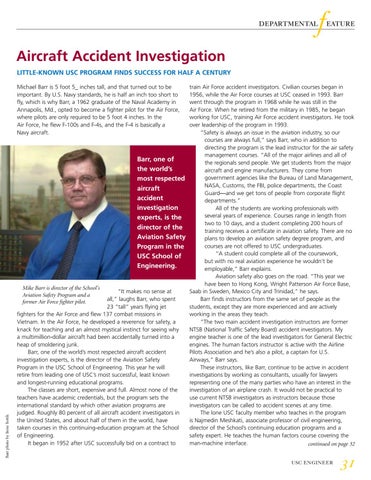f
departmental eature
Aircraft Accident Investigation LITTLE-KNOWN USC PROGRAM FINDS SUCCESS FOR HALF A CENTURY
Barr photo by Irene Fertik
Michael Barr is 5 foot 5_ inches tall, and that turned out to be important. By U.S. Navy standards, he is half an inch too short to fly, which is why Barr, a 1962 graduate of the Naval Academy in Annapolis, Md., opted to become a fighter pilot for the Air Force, where pilots are only required to be 5 foot 4 inches. In the Air Force, he flew F-100s and F-4s, and the F-4 is basically a Navy aircraft.
train Air Force accident investigators. Civilian courses began in 1956, while the Air Force courses at USC ceased in 1993. Barr went through the program in 1968 while he was still in the Air Force. When he retired from the military in 1985, he began working for USC, training Air Force accident investigators. He took over leadership of the program in 1993. “Safety is always an issue in the aviation industry, so our courses are always full,” says Barr, who in addition to directing the program is the lead instructor for the air safety management courses. “All of the major airlines and all of Barr, one of the regionals send people. We get students from the major the world’s aircraft and engine manufacturers. They come from government agencies like the Bureau of Land Management, most respected NASA, Customs, the FBI, police departments, the Coast aircraft Guard—and we get tons of people from corporate flight accident departments.” investigation All of the students are working professionals with several years of experience. Courses range in length from experts, is the two to 10 days, and a student completing 200 hours of director of the training receives a certificate in aviation safety. There are no Aviation Safety plans to develop an aviation safety degree program, and courses are not offered to USC undergraduates. Program in the “A student could complete all of the coursework, USC School of but with no real aviation experience he wouldn’t be Engineering. employable,” Barr explains. Aviation safety also goes on the road. “This year we have been to Hong Kong, Wright Patterson Air Force Base, Mike Barr is director of the School's “It makes no sense at Saab in Sweden, Mexico City and Trinidad,” he says. Aviation Safety Program and a all,” laughs Barr, who spent Barr finds instructors from the same set of people as the former Air Force fighter pilot. 23 “tall” years flying jet students, except they are more experienced and are actively fighters for the Air Force and flew 137 combat missions in working in the areas they teach. Vietnam. In the Air Force, he developed a reverence for safety, a “The two main accident investigation instructors are former knack for teaching and an almost mystical instinct for seeing why NTSB (National Traffic Safety Board) accident investigators. My a multimillion-dollar aircraft had been accidentally turned into a engine teacher is one of the lead investigators for General Electric heap of smoldering junk. engines. The human factors instructor is active with the Airline Barr, one of the world’s most respected aircraft accident Pilots Association and he’s also a pilot, a captain for U.S. investigation experts, is the director of the Aviation Safety Airways,” Barr says. Program in the USC School of Engineering. This year he will These instructors, like Barr, continue to be active in accident retire from leading one of USC’s most successful, least known investigations by working as consultants, usually for lawyers and longest-running educational programs. representing one of the many parties who have an interest in the The classes are short, expensive and full. Almost none of the investigation of an airplane crash. It would not be practical to teachers have academic credentials, but the program sets the use current NTSB investigators as instructors because those international standard by which other aviation programs are investigators can be called to accident scenes at any time. judged. Roughly 80 percent of all aircraft accident investigators in The lone USC faculty member who teaches in the program the United States, and about half of them in the world, have is Najmedin Meshkati, associate professor of civil engineering, taken courses in this continuing-education program at the School director of the School’s continuing education programs and a of Engineering. safety expert. He teaches the human factors course covering the It began in 1952 after USC successfully bid on a contract to man-machine interface. continued on page 32 USC ENGINEER
31
